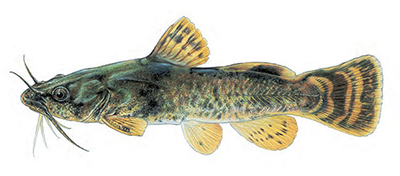Northern Madtom

Photo credit: Joseph R. Tomelleri
Species information
The following is a report on the progress towards the protection and recovery of Northern Madtom (Notorus stigmosus) in Ontario, from 2007 to 2018, based on species-specific policy. This report meets the legislative requirement for a review of progress under the Endangered Species Act, 2007 (ESA or “the Act”). Northern Madtom is listed as endangered on the Species at Risk in Ontario (SARO) List under the ESA.
Northern Madtom has been classified as a species at risk since 2000. It was originally classified as threatened in 2000, and then endangered in 2004, and retained its ‘endangered’ status under the ESA, when it came into force in 2008.
As an endangered species, Northern Madtom has been protected from being killed, harmed, harassed, captured or taken, under the ESA, since 2008.
In addition, its habitat has been protected from being damaged or destroyed since 2013, under the general definition of habitat in the Act.
The species-specific policy for Northern Madtom, known as the Government Response Statement (GRS), was published in 2014, and includes the government’s recovery goal for the species, and the actions and priorities it leads or supports to help achieve that goal. The GRS considers science advice provided in the recovery strategy when developing recovery actions for the species. As legislated in the Act, the purpose of the Review is to report on progress made towards implementing the protection and recovery actions in the GRS. The Review can also help identify opportunities to adjust and adapt the implementation of protection and recovery actions to achieve the recovery goal for the species.
Further information about Northern Madtom, including the threats that it faces, and actions being taken to help protect and recover the species, is available on the Government of Ontario webpage for Northern Madtom. A summary of progress made towards the protection and recovery of Northern Madtom, and an annual update on the species at risk program, are available on the Review of Progress towards the Protection and Recovery of Ontario’s Species at Risk webpage.
Snapshot
Progress towards the protection and recovery of Northern Madtom
- The recovery goal in the Government Response Statement (GRS) for Northern Madtom in Ontario is to
maintain existing populations at current locations in the Lake Erie-Huron corridor (St. Clair River, Lake St. Clair, the Detroit River), and Thames River (the reach of river from Littlejohn Rd. upstream to an area near Tate Corners).
- Progress has been made towards implementing all government-led actions. Progress has also been made towards achieving all government-supported recovery objectives, and implementing all associated actions. Examples of progress include:
- Conducting inventory and monitoring at known and historical locations to improve understanding of the status of populations and habitat requirements
- Supporting partners to undertake activities to protect and recover Northern Madtom and its habitat
- Promoting awareness of best management practices (BMPs) to improve habitat conditions and water quality in areas with Northern Madtom through education and outreach
- In alignment with the GRS, further work is needed to evaluate the seasonal habitat requirements for all life stages of Northern Madtom and investigate the effects of potential threats (for example, chemical pollutants, physical habitat loss, and invasive species) on Northern Madtom populations.
Occurrence and distribution
- Five populations
footnote 1 of Northern Madtom have been documented in Ontario in Lake St. Clair and the St. Clair, Detroit, Sydenham and Thames rivers. Currently, four of these populations are extant, whereas one population is considered historicalfootnote 2 . - Since 2008, the status of one population changed from extant to historical based on the date that it was last observed, and the status of three populations have been re-confirmed through monitoring efforts.
Government-supported stewardship projects
- Through the Species at Risk Stewardship Program, the Government of Ontario has enabled its stewardship partners to conduct 12 projects ($703,115) that have supported the protection and recovery of multiple species at risk, including Northern Madtom.
- The government’s support helped its stewardship partners to involve 77 individuals who volunteered 405 hours of their time towards protection and recovery activities for species at risk, including Northern Madtom. The estimated value of these voluntary contributions, as well as additional funding and in-kind support, is $1,110,688.
- Stewardship partners reported that through their actions 167 hectares of habitat were enhanced for Northern Madtom and other species at risk that inhabit the same ecosystem.
- Stewardship partners reported providing outreach on multiple species at risk, including Northern Madtom to 190,475 individuals.
- Through the Species at Risk Research Fund for Ontario, the Government of Ontario supported a research partner to conduct an environmental DNA (eDNA) study to detect the presence of multiple species at risk, including Northern Madtom.
Supporting human activities while ensuring appropriate support for species recovery
- The Government of Ontario has issued nine permits for this species, all of which were ‘protection or recovery’ permits, issued under clause 17(2)(b) of the ESA.
- Eight drainage agreements were entered into for Northern Madtom, as enabled through Ontario Regulation 242/08 (prior to the July 1, 2013 amendment).
- Twelve activities have been registered for the species under the ‘Drainage works’ (section 23.9), ‘Species protection, recovery activities’ (section 23.17), ‘Threats to health and safety, not imminent’ (section 23.18), and ‘Incidental trapping’ (section 23.19) sections of Ontario Regulation 242/08, under the ESA.
Reporting on progress towards the protection and recovery of Northern Madtom
Recovery goal
The government’s goal for the recovery of Northern Madtom is to maintain existing populations at current locations in the Lake Erie-Huron corridor (St. Clair River, Lake St. Clair, the Detroit River), and Thames River (the reach of river from Littlejohn Rd. upstream to an area near Tate Corners).
The implementation of government-led and government-supported actions demonstrates progress towards reaching the desired objectives and the recovery goal set out in the GRS.
Progress towards implementing government-led actions
Progress has been made towards implementing all the government-led actions in the GRS. Common actions for the government to lead as it works toward achieving a species’ recovery goal include:
- Educate other agencies and authorities involved in planning and environmental assessment processes on the protection requirements under the ESA.
- Encourage the submission of Northern Madtom data to the government’s central repository at the Natural Heritage Information Centre (NHIC).
- Undertake communications and outreach to increase public awareness of species at risk in Ontario.
- Protect the Northern Madtom and its habitat through the ESA.
- Support conservation, agency, municipal and industry partners, and Indigenous communities and organizations to undertake activities to protect and recover Northern Madtom. Support will be provided where appropriate through funding, agreements, permits (including conditions) and/or advisory services.
- Encourage collaboration, and establish and communicate annual priority actions for government support in order to reduce duplication of efforts.
Additionally, the government has directly undertaken the following species-specific action:
- Continue to implement the Ontario Invasive Species Strategic Plan to address the invasive species (e.g. Round Goby (Neogobius melanostomus) and Zebra Mussel (Dreissena polymorpha)) that threaten Northern Madtom.
Key progress made towards implementing these actions is described in the following sections.
Ontario’s Invasive Species Act
The GRS for Northern Madtom indicates that invasive species (e.g., Round Goby) pose a threat to the survival and recovery of the species in Ontario. The Ontario Invasive Species Strategic Plan, 2012 and the Invasive Species Act, 2015 provide the policy and legislative framework to support the prevention, detection and control of invasive species in Ontario. This framework may support the implementation of actions to reduce threats from invasive species.
Occurrence and distribution
Five populations
Since 2008, the government’s central repository at the Natural Heritage Information Centre (NHIC) has received approximately 122 records of the species. These records are based on observations between 1963 and 2013 and come from a variety of sources. Records submitted have helped to refine where the species is known and has been known to occur and can provide additional information on the species’ habitat and threats.
Inventory and monitoring efforts since 2008 have re-confirmed the presence of three populations in the Detroit, St. Clair and Thames rivers. Several juveniles have also been collected in the Detroit, St. Clair and Thames rivers, suggesting that reproduction is occurring in these waterbodies. The viability
It is possible that there are observations of Northern Madtom that have not been submitted to the government. Encouraging the submission of observations of this species is included in the GRS as a government-led action. Submission of species observations increases our knowledge of where they occur and can play an important role in assessing the viability of species populations.
Everyone is encouraged, or may be required by an authorization or approval to submit observations of Northern Madtom, and any other species at risk observed, to the NHIC for incorporation into the provincial record of observations. Observations may now be submitted to NHIC via the Rare Species of Ontario project in iNaturalist.
-
122observations of this species were submitted to the NHIC since 2008
Government-supported stewardship projects
An important government-led action in the GRS for Northern Madtom is to support partners to undertake activities to protect and recover the species. Through the Species at Risk Stewardship Program the government has supported 12 projects ($703,115) designed to contribute to the protection and recovery of multiple species at risk, including Northern Madtom
Stewardship partners reported that provincial funding helped them to secure in-kind support by involving 77 individuals who volunteered 405 hours of their time towards protection and recovery activities for multiple species at risk, including Northern Madtom, which has an estimated value of $21,425. Partners also reported, that through both their efforts and the efforts of their volunteers to implement GRS actions, they were successful in enhancing 167 hectares of habitat that will benefit multiple species at risk, including Northern Madtom. In addition, stewardship partners reported providing ecosystem-based outreach on multiple species, including Northern Madtom to 190,475 individuals.
The government also supports partners in conducting research that addresses important knowledge gaps for species at risk. Through the Species at Risk Research Fund for Ontario, funding was provided to a partner to conduct an environmental DNA (eDNAM) study to help inform the status and distribution of populations and to characterize the genetic variation of species at risk, including Northern Madtom.
The remainder of this section highlights a project supported through the Species at Risk Stewardship Program.
In 2008, the Essex Region Conservation Authority received stewardship funding to implement a project called “Essex-Erie Region Fish Species at Risk Outreach and Education Project.” The project focused on delivering education and outreach programs as well as restoring and enhancing fish habitat in the Essex-Erie Region to benefit multiple species at risk, including Northern Madtom. A targeted landowner engagement plan was developed and implemented with a focus on improving habitat and water quality conditions for fish species at risk in the Detroit River and Lake St. Clair watersheds, where Northern Madtom is found. This included distributing outreach material, delivering presentations, seminars and workshops and developing site-specific restoration plans for interested land owners. As a result, a total of eight projects covering over 18 hectares were developed for implementation to restore aquatic species at risk habitat. A curriculum-based education program was also delivered to students in the region to learn about fish species at risk and threats facing their survival. In total, over 1,826 students participated in the program. This project contributes to progress towards achieving the GRS objective (and implementing the associated action) to engage landowners and key stakeholders in stewardship activities to improve habitat and to develop outreach materials that highlight the importance of minimizing threats to the species’ habitat.
Species at Risk Stewardship Program
-
 12
12projects included Northern Madtom
-
 $703,115
$703,115for multi-species projects that included Northern Madtom
-
 $1,110,688
$1,110,688in additional funding and in-kind support
-
 77
77volunteers
-
 405
405volunteer hours
-
 190,475
190,475people received outreach
-
 167
167hectares of habitat enhanced
Supporting human activities while ensuring appropriate support for species recovery
Supporting partners through permits and their associated conditions is an important government-led action.
Nine permits have been issued for Northern Madtom since the species has been protected under the ESA, all of which were ‘protection or recovery’ (17(2)(b)) permits. ‘Protection or recovery’ permits are issued if the purpose of the activity is to assist in the protection or recovery of a species at risk. Of the nine permits, one was issued exclusively for Northern Madtom, and eight were issued for multiple species, including Northern Madtom. The projects were primarily related to inventory and monitoring at known and historical locations to fill knowledge gaps related to the status, distribution, spawning success, and habitat requirements of Northern Madtom and other species at risk. A multi-species permit was also issued to determine the success of shoreline softening projects in restoring species at risk habitat.
Eight drainage agreements were entered into for Northern Madtom. These agreements were enabled through Ontario Regulation 242/08 (prior to the July 1, 2013 amendment). Conditions of the agreements involve implementing actions in the mitigation plan, including, but not limited to:
- Undertaking appropriate mitigation measures for sediment and erosion control and bank stabilization;
- Mapping sensitive areas for the species before undertaking any work; and,
- Contacting the government to seek further direction where a proposed activity will occur in a sensitive area for a fish species.
Twelve activities that may affect Northern Madtom or its habitat have been registered under various sections of Ontario Regulation 242/08, under the ESA - six under ‘Drainage works’ (section 23.9), three under ‘Species protection, recovery activities’ (section 23.17), two under ‘Threats to health and safety, not imminent’ (section 23.18), and one under ‘Incidental trapping’ (section 23.19). These registrations require the registrant to comply with all conditions of the Regulation, such as: ensuring that reasonable steps are taken to minimize adverse effects of the activity on the species identified in the notice of activity form; preparing a mitigation plan using best available information on steps that may help minimize or avoid adverse effects on the species; and, submitting observations of the species to the NHIC, using the Ontario Species at Risk Observation Reporting Form.
-
9protection or recovery permits
-
8agreements
-
12registrations
Progress towards implementing government-supported actions
Government-supported actions are organized under overarching recovery objectives. Progress has been made towards achieving all government-supported recovery objectives, and implementing all associated actions that are identified in the GRS for Northern Madtom.
Objective: Improve knowledge of the species’ populations, habitat requirements and major threats.
- Action No. 1 (High Priority) – Conduct targeted sampling in areas of suitable and potentially suitable habitat in the Lake Erie-Huron corridor and Thames River to determine population demographics and detect new occurrences. Sampling should be conducted using techniques known to detect Northern Madtom.
- Action No. 2 – Implement a standardized population and habitat monitoring program and evaluate the seasonal habitat needs (including home range and species movement) of all life-stages of Northern Madtom.
- Action No. 3 – Investigate the effects of chemical pollutants, physical habitat loss, and invasive species (i.e. Round Goby, Zebra Mussel) on Northern Madtom in the Huron-Erie corridor; and the effects of nutrient loading, siltation and turbidity on Northern Madtom in the Thames River.
Under this objective, progress has been made towards implementing Action No. 1 through projects supported by the Species at Risk Stewardship Program and through conditions of ESA authorizations. Targeted surveys for Northern Madtom at known and historical locations, including Lake St. Clair, and the St. Clair, Thames, Sydenham and Detroit rivers have provided valuable information on the status and distribution of populations.
Progress has also been made towards implementing Action No. 2 through projects investigating the effectiveness of sampling methods (e.g., optimal gear type, sampling effort, detection probabilities) to detect species at risk, including Northern Madtom and to fill knowledge gaps regarding the status, movement, habitat use and spawning success of Northern Madtom in the St. Clair – Detroit River System.
Initial progress has been made towards implementing Action No. 3, through stream habitat and water quality assessments in the Thames River, supported by the Species at Risk Stewardship Program.
Objective: Engage landowners and key stakeholders in stewardship activities to improve habitat and reduce threats.
- Action No. 4 (High Priority) – Work with landowners, agricultural operations, drainage supervisors, and conservation authorities to minimize threats to the species’ habitat by encouraging:
- the development and implementation of Environmental Farm Plans and Nutrient Management Plans; and,
- implementation of BMPs at highly degraded sites in and around the species’ habitat to prevent or reduce siltation, turbidity, and toxic pollutants in Northern Madtom habitat.
- Action No. 5 – Continue riparian and hardened shoreline rehabilitation in collaboration with existing aquatic ecosystem recovery efforts.
Under this objective, considerable progress has been made towards implementing all actions, through projects supported by the Species at Risk Stewardship Program, and the conditions of ESA authorizations. Partners including conservation authorities have undertaken outreach and stewardship projects to work directly with landowners in rural areas and encourage the use of BMPs to improve water quality by reducing sediment load and nutrient input in Northern Madtom habitat areas. For example, BMPs and habitat restoration activities have been conducted in the Sydenham and Thames rivers, as well as in the Essex-Erie Region (tributaries of Lake St. Clair and the Detroit River) to benefit multiple species at risk, including Northern Madtom. Riparian buffer and wetland restoration projects have also been completed along municipal drains to improve water quality for downstream features that support aquatic species at risk in the Lake St. Clair and Thames River watersheds, where Northern Madtom are found.
Objective: Promote BMPs and the importance of minimizing threats to the species’ habitat among land managers and communities.
- Action No. 6 – Develop outreach materials that highlight the threats to Northern Madtom and the importance of implementing BMPs to reduce siltation and turbidity and reduce the input of toxic compounds. Distribute materials to nearby conservation partners, Indigenous communities, the fishing community, and other key stakeholders.
Under this objective, progress has been made towards implementing Action No. 6 through outreach and education campaigns supported by the Species at Risk Stewardship Program. Presentations, seminars, workshops, education programs and materials (e.g., brochures, flyers, mailouts, guidebooks) have been delivered to local landowners, school groups, and community members to increase knowledge of species at risk, including Northern Madtom and promote the importance of BMPs to enhance water quality and river health, and encourage community involvement in stewardship activities.
Summary of progress towards meeting the recovery goal
The recovery goal for Northern Madtom is to maintain existing populations at current locations in the Lake Erie-Huron corridor (St. Clair River, Lake St. Clair, the Detroit River), and Thames River (the reach of river from Littlejohn Rd. upstream to an area near Tate Corners).
Effort made towards implementing government-led and government-supported actions has contributed to progress towards this goal. For example, recent observations submitted to the Natural Heritage Information Centre have provided important information regarding the abundance and distribution of populations. Surveys have confirmed the continuing presence of three populations and that reproduction is likely occurring within the Detroit, St. Clair and Thames rivers, including the area between Littlejohn Road to Tate Corners. Considerable effort has been made towards restoring and/or enhancing habitat in Northern Madtom areas to contribute to towards improving the quality of the species’ habitat to support its persistence.
A federal report on the progress made towards implementing the Recovery Strategy for Northern Madtom in Canada has been prepared by Fisheries and Oceans Canada and provides an update on the work done for the species from 2012 to 2016. Progress made towards meeting the objectives listed in the federal Recovery Strategy for Northern Madtom can be found on the Government of Canada website and the associated actions undertaken to meet these objectives may also contribute towards meeting the species’ recovery goal set out in the GRS.
Recommendations
As stated in the GRS, this Review of Progress can be used to help identify whether adjustments to the implementation of GRS actions are needed to achieve the protection and recovery of the species. Based on progress to date, the overall direction provided in the GRS for Northern Madtom, particularly the implementation of actions identified as high priority, should continue to guide protection and recovery of the species.
Although initial progress has been made towards implementing Action No. 2, further work is needed to fully implement a standardized monitoring program and to evaluate the seasonal habitat needs of all life-stages of Northern Madtom. While progress has been made to maintain the current distribution of the species, further survey effort is required in the Sydenham River and Lake St. Clair to determine the current status of these populations, as individuals have not been collected here since 1975 and 1999, respectively. Additional work is also required to evaluate the effects of threats including invasive species, nutrient loading and habitat loss on Northern Madtom populations to help support the species’ recovery (Action No. 3).
Protecting and recovering Northern Madtom will continue to be a shared responsibility that will require the involvement of many individuals, organizations and communities. Financial support for the implementation of actions may be available through the Species at Risk Stewardship Program. The government can also advise if any authorizations under the ESA or other legislation may be required to undertake a project. By working together, we can continue to make progress towards protecting and recovering Northern Madtom in Ontario.
Footnotes
- footnote[1] Back to paragraph For the purposes of this report, a population is defined as an area of land and/or water on/in which an element (for example, Northern Madtom) is or was present. They are comprised of one or more observations and the area has a practical conservation value as it is important to the conservation of the species. An element occurrence is the technical term used to describe this.
- footnote[2] Back to paragraph A population is considered historical if it has not been recorded within the last 20 years. Historical populations may still exist, but updated information is not available.
- footnote[3] Back to paragraph Viability is defined as the probability that a population/occurrence will persist based on its size (including population size and/or occupied area), environmental conditions, and landscape context.
- footnote[4] Back to paragraph Some projects supported through the Species at Risk Stewardship Program may require a 17(2)(b) permit in order to carry out the project. As a result, some 17(2)(b) permits included in this report may have been issued to authorize those projects.